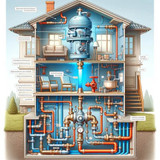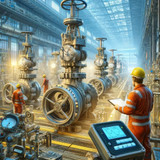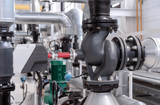Valve Positioner H
There are no products listed under this category.
What is a Valve Positioner?
A valve positioner is an essential device used in industrial applications to precisely control the position and movement of valves. It plays a vital role in ensuring accurate and efficient operation of valves within a plant's system.
Valve positioners enhance the performance of valves by providing precise control over the valve's position, allowing for optimal flow regulation and process control. By accurately positioning the valve, it enables smooth and reliable operation, minimizing wear and tear on valves and associated equipment.
Designed for use in various industries such as manufacturing, oil and gas, and chemical processing, valve positioners offer advanced features and functionality. They integrate with control systems to receive signals and precisely adjust the position of the valve based on the desired setpoint or process conditions.
By using a valve positioner, operators can achieve improved accuracy, responsiveness, and repeatability in valve control. This translates into enhanced process efficiency, reduced maintenance costs, and increased overall productivity.
When integrating a valve positioner into a plant's system, it is crucial to install it upstream of any other valves, regulators, or control devices. This placement ensures that the valve positioner can effectively and accurately control the valve's position and maintain optimal performance.
Investing in a high-quality valve positioner is a wise choice for industries relying on critical and expensive equipment. It ensures precise control, enhances system reliability, and safeguards valves and instrumentation from damage or premature wear.
In summary, a valve positioner is an indispensable component in industrial settings, providing precise control over valve positioning and optimizing process control for improved efficiency and equipment protection.
Our Posts
View AllUnderstanding Valve Sizes and Measurement
Sizing the appropriate valve is critical to ensuring the performance of your system. Whether you'r …
Read MoreTypes of Water Valves
Hey there, fellow valve enthusiasts! We all know that valves play a crucial role in regulating th …
Read MoreWhat is a Backflow Preventer, and How Does it Work?
When a simple check valve is inadequate for the job, you need a backflow preventer. But knowing …
Read MoreValve inspection - main points of valve testing in Manufacture setting
Industrial facilities rely on different types of valves (such as check valves, for example) to con …
Read MoreTypes of Ball Valves
Ball valves are important components in a vast range of systems, from small family-owned workshops …
Read MoreUnderstanding valve standards and specifications
Hey there, fellow valve enthusiasts! Today, we're looking at valve codes, standards and specifica …
Read MoreHow to Tell if a Valve is On or Off
We have all been there before. You are staring at a valve; you know that you should know if it …
Read MoreUnderstanding Different Types of Valve Connections and Fittings
Hey there, fellow valve enthusiasts! We know valves play a crucial role in regulating the flow of li …
Read MoreTypes of Valve Handles: Lever and Handwheels
Whether you're involved in industrial work, plumbing, or you're a DIY enthusiast, you come across va …
Read MoreThe Basic Parts of a Valve
Valves quietly work in many different areas, even places you wouldn't expect. They're truly every …
Read MoreGas Ball Valves In Industrial Applications - 5 Things to Keep in Mind
Unlike the standard ball valves, most gas ball valves are tested and approved by CSA. These valves a …
Read MoreHow To Correctly Use A 3 Way Valve In Different Applications
To understand the "T"-port and an "L"-port 3-way valves and what makes them different, it's importan …
Read MoreIndustrial Ball Valves - 9 Questions To Make The Right Choice
Ball valves are versatile flow control devices suitable for extensive industrial applications. They …
Read MoreEverything you need to know about valve types
Valves play crucial roles in production lines and equipment performance across a multitude of ind …
Read MoreWhat is a Duty Cycle and How Does it Relate to Electric Ball Valves?
Electric actuation improves the efficiency of processes by maintaining the accuracy of the re …
Read MoreActuated Butterfly Valves 101: All You Need To Know About Their Application In Piping Systems
Butterfly valves are quarter-turn flow control or isolation devices, used for quick shut-off in p …
Read MorePractical Guide To Electric and Pneumatic Actuators – Which One To Choose?
While electrical and pneumatic actuators have several unique benefits and are preferred in differ …
Read MoreHow Do Check Valves Affect Water Pressure in the Piping System?
Check valves also known as "one-way" valves are autonomously operated unidirectional valves that all …
Read MoreUsing an Actuated Ball Valve Or a Solenoid Valve For Best Fluid Control In The System
Both ball valves and solenoid valves serve a wide variety of applications. From a&nb …
Read MoreWhat are the types of solenoid valves?
Favored for offering low power consumption, a compact space envelope, superior speed of ope …
Read More


















